Key takeaways:
- Organic wine production emphasizes nurturing land and biodiversity without synthetic chemicals, showcasing a natural approach to viticulture.
- Biodynamic principles enhance organic practices by incorporating lunar cycles and natural preparations to enrich soil and promote self-sustainability.
- Certification for biodynamic wine involves strict adherence to regulations, focusing on transparency, authenticity, and ecological stewardship.
- Successful biodynamic production relies on deep land connection, collaboration with other producers, and patience throughout the learning process.

Understanding organic wine production
Organic wine production revolves around the fundamental principle of nurturing the land and vines without synthetic chemicals. I recall my first encounter with organic vineyards; it felt like stepping into a world where the soil was alive, thriving with microbial activity. Can you imagine the purity of wine made from grapes that have been tended to with such care?
In the world of organic wine, every decision impacts the final product. I remember visiting a vineyard where they used natural pest deterrents, like planting garlic and other herbs, instead of fungicides. It was inspiring to witness how these choices not only protected the grapes but also enriched the overall ecosystem. Isn’t it fascinating how nature can offer solutions if we just listen?
Furthermore, organic wine production isn’t just about eliminating chemicals; it’s also about embracing biodiversity. I often think about my experiences in vineyards that practice polyculture, where various plants coexist. This approach fosters a rich habitat for beneficial insects and contributes to the overall health of the vines. Why do you think these principles resonate so deeply with today’s conscious consumers? It’s about connection—between the land, the wine, and the people who cherish it.
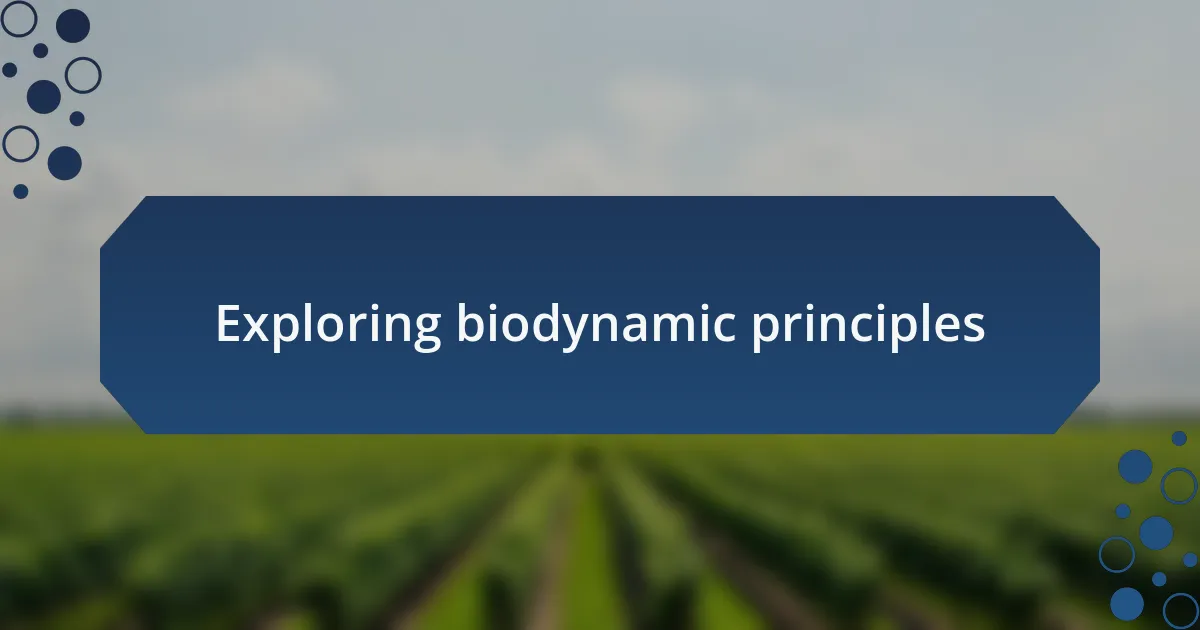
Exploring biodynamic principles
Biodynamic principles extend the organic philosophy by integrating astrological cycles and a holistic approach to farming. I remember visiting a biodynamic vineyard, where the winemaker spoke passionately about the lunar phases affecting grape growth. It struck me how deeply intertwined nature’s rhythms are with our agricultural practices. Have you ever considered how the moon might influence the flavors of wine?
One key aspect of biodynamics is the preparation of specific natural substances to enhance soil vitality. I found it fascinating when the vineyard owner described using fermented cow horns filled with manure, known as “horn manure.” This preparation is buried in the soil to energize it, fostering a vibrant ecosystem for the vines. Hearing about such unconventional methods made me reflect on the creativity and commitment required to truly embrace this approach. Isn’t it remarkable how ancient practices can contribute to modern sustainability?
Another significant principle is viewing the vineyard as a self-sustaining system. During my time working at a biodynamic estate, I witnessed how composting and cover crops played a pivotal role in maintaining soil health. It was a revelation to see the vineyard thrive without reliance on external inputs, created by the very land itself. How empowering is it to cultivate wine with such consideration for the environment? Each step taken felt like a pact with nature, enhancing both the wine’s integrity and the land’s legacy.
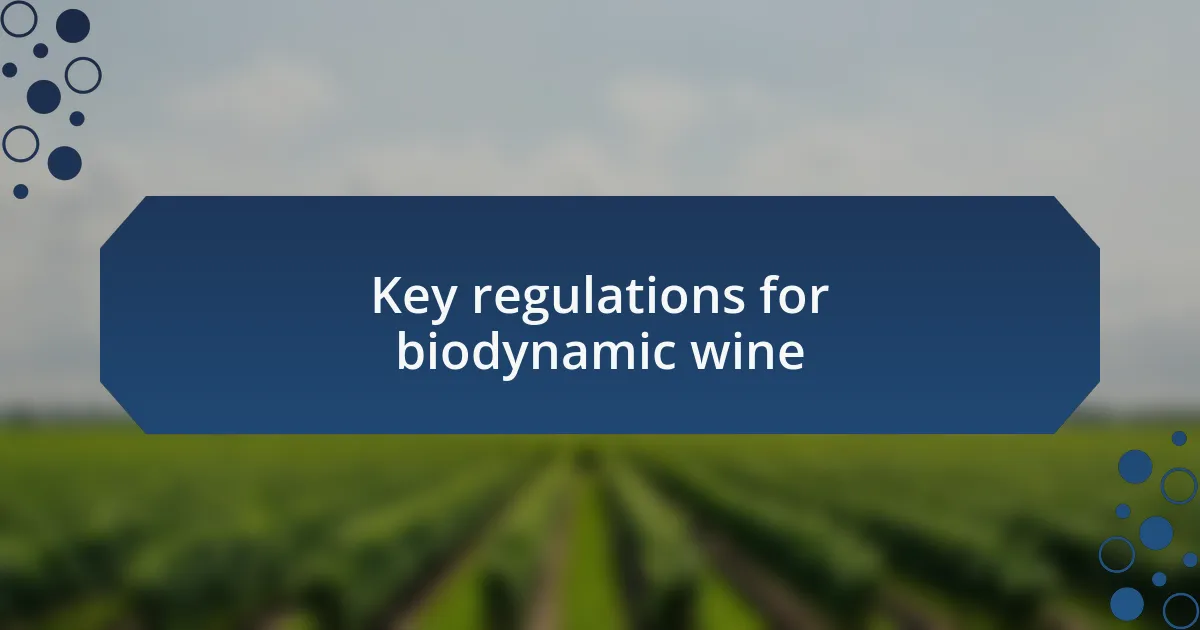
Key regulations for biodynamic wine
One of the foundational regulations in biodynamic wine production is the prohibition of synthetic chemicals and additives. I remember the first time I learned about this during a vineyard tour; it was astonishing to realize that every ounce of the wine comes from a completely natural process. Can you imagine the level of trust and transparency required to produce wine without the safety net of modern chemistry?
Another essential rule revolves around following the lunar calendar for planting and harvesting. In my experience, this practice isn’t merely about tradition; it’s rooted in the belief that cosmic influences can impact plant growth. I once tasted a vintage that the winemaker claimed was picked during a full moon, and it was nothing short of ethereal—where do you find such depth of flavor in conventional wines?
Furthermore, biodynamic certification is overseen by organizations that require adherence to strict practices. Each vineyard I’ve visited has taken immense pride in their certification process, showcasing meticulous record-keeping and a commitment to transparent practices. It’s invigorating to see this level of dedication to integrity; who wouldn’t be inspired by winemakers so invested in the art of their craft?
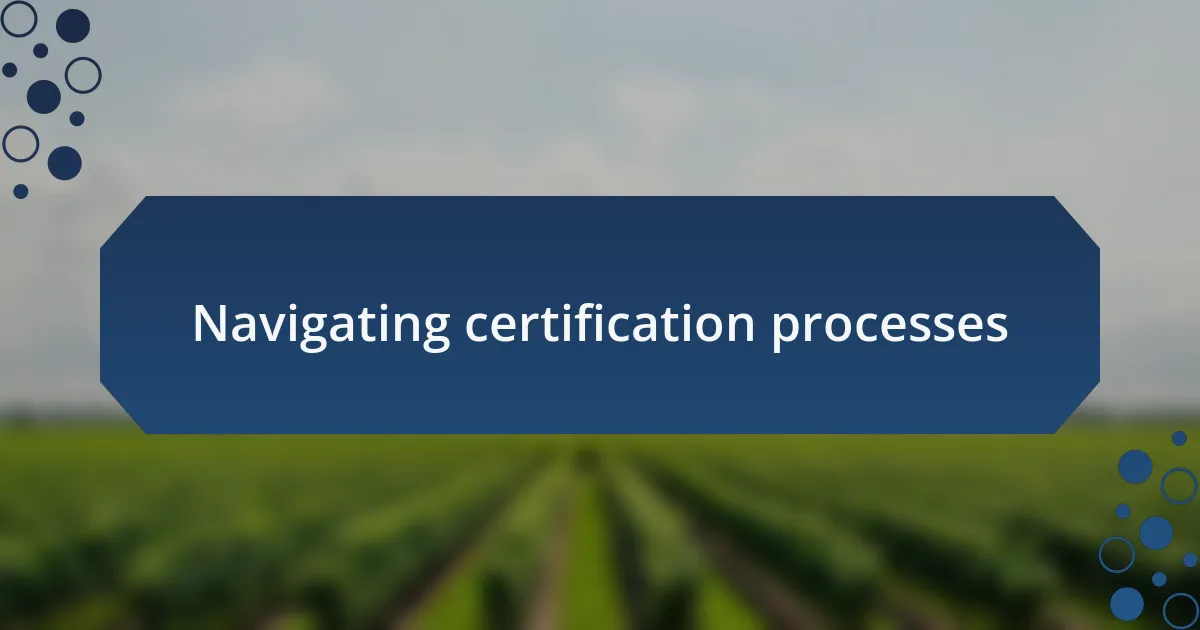
Navigating certification processes
Navigating the certification processes for biodynamic wine can feel overwhelming at first, but the journey is deeply rewarding. I recall the moment I submitted my vineyard’s application; it was both exhilarating and nerve-wracking. The paperwork seemed endless, but the sense of purpose fueled my determination—how could one not want to be part of something that emphasizes such holistic practices?
I learned that having a strong relationship with the certifying body is vital. During my experience, my consultant was instrumental, guiding me through the complexities of their standards. There were times when I felt lost in the nuances of biodynamic principles, but having someone who understood it all made the process smoother. Have you ever felt overwhelmed by bureaucratic details? I found that asking questions not only cleared my confusion but also reinforced my commitment to the biodynamic philosophy.
As I navigated through inspections, it was clear that authenticity was scrutinized closely. I vividly remember the inspector’s visit; it was a mixture of anxiety and anticipation. Yet, when I shared my vineyard’s story and practices, I began realizing that these interactions were as much about sharing passion as they were about compliance. Isn’t it enlightening to think that a certification isn’t just a paper—it’s a testament to a philosophy of integrity and ecological stewardship?
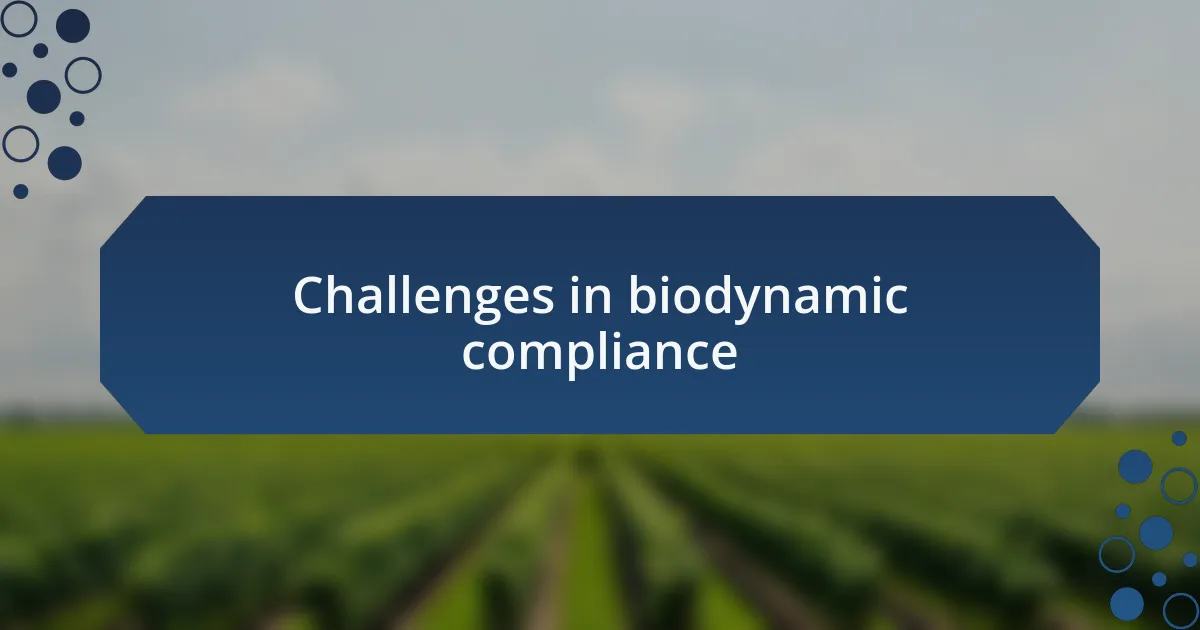
Challenges in biodynamic compliance
The journey through biodynamic compliance presents its fair share of challenges. One particular hurdle I faced was understanding the intricacies of the biodynamic calendar. Following lunar cycles for planting and harvesting felt almost like learning a new language. Have you ever tried to align your schedule with something so fluid? It required constant attention and adaptability.
Another challenge came from sourcing biodynamic preparations. The first time I looked for specific herbal concoctions, I felt like I was on a scavenger hunt with few clues. It was both frustrating and exhilarating to discover suppliers who shared my passion, but the process tested my perseverance. How do you maintain that balance between passion and practicality? I often had to remind myself that the authenticity of my practices was worth every effort, even if it meant long hours of searching and networking.
I also encountered the complexity of documenting every step of the process. I remember sitting late at night, poring over my records, trying to ensure compliance while also preserving my authentic winemaking style. It felt daunting, ensuring every detail was meticulously noted. But amidst that challenge, there was a sense of fulfillment as I reflected on the journey. Does documenting our endeavors help solidify our commitment to our craft? In a way, I believe it does—it showcases not just compliance, but a rich narrative of how far we’ve come in our biodynamic pursuit.
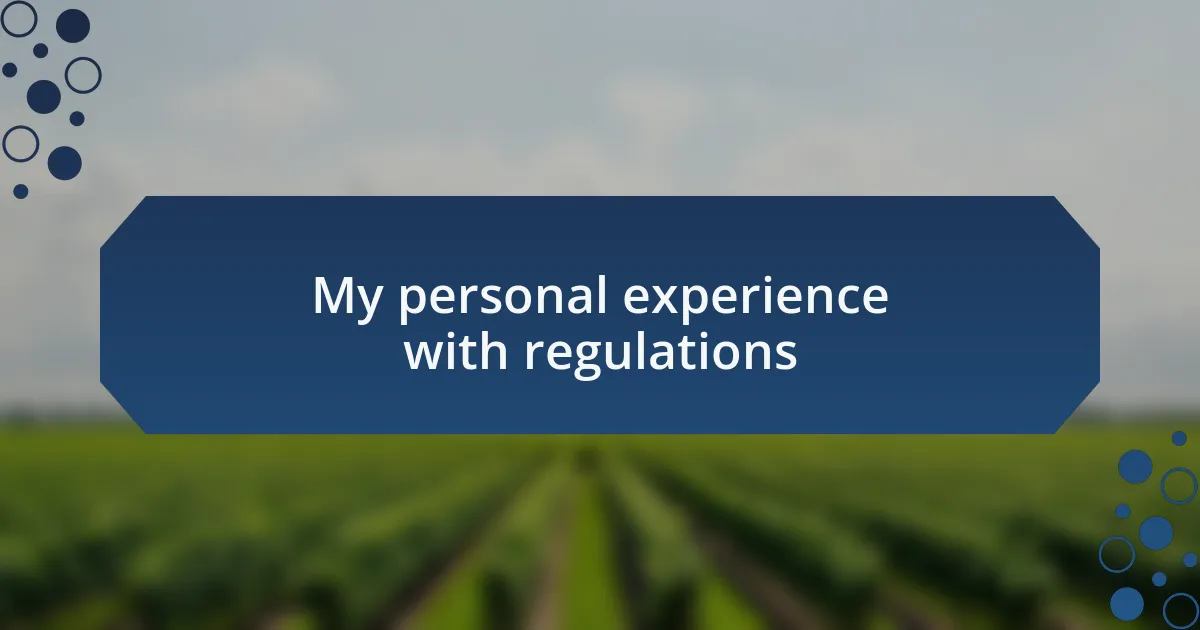
My personal experience with regulations
Navigating the regulations around biodynamic practices felt like stepping into a maze. I recall the first time I attended a compliance workshop, surrounded by experienced vintners. Their insights were invaluable, yet I couldn’t shake the feeling of imposter syndrome. Am I truly equipped to meet these standards? The pressure to conform weighed heavily on me, yet each conversation sparked my determination to succeed.
One moment that stands out to me was during an unannounced inspection. My heart raced as the inspector examined my vineyard, searching for compliance with biodynamic principles. I felt exposed, like I was being scrutinized under a magnifying glass. But as we discussed my practices, I realized that my passion for authenticity resonated with them. It made me wonder—do we sometimes worry too much about being judged rather than celebrating our unique approaches?
The paperwork was equally daunting. I was tasked with ensuring that every practice I implemented was documented meticulously. The first time I submitted my records, I felt a mix of anxiety and relief. Would it reflect my commitment? I found myself questioning if I was doing enough to honor biodynamic principles. Those moments of self-doubt were tough, but they made me appreciate the journey even more. What if our struggles ultimately define our achievements? In my case, they certainly do.
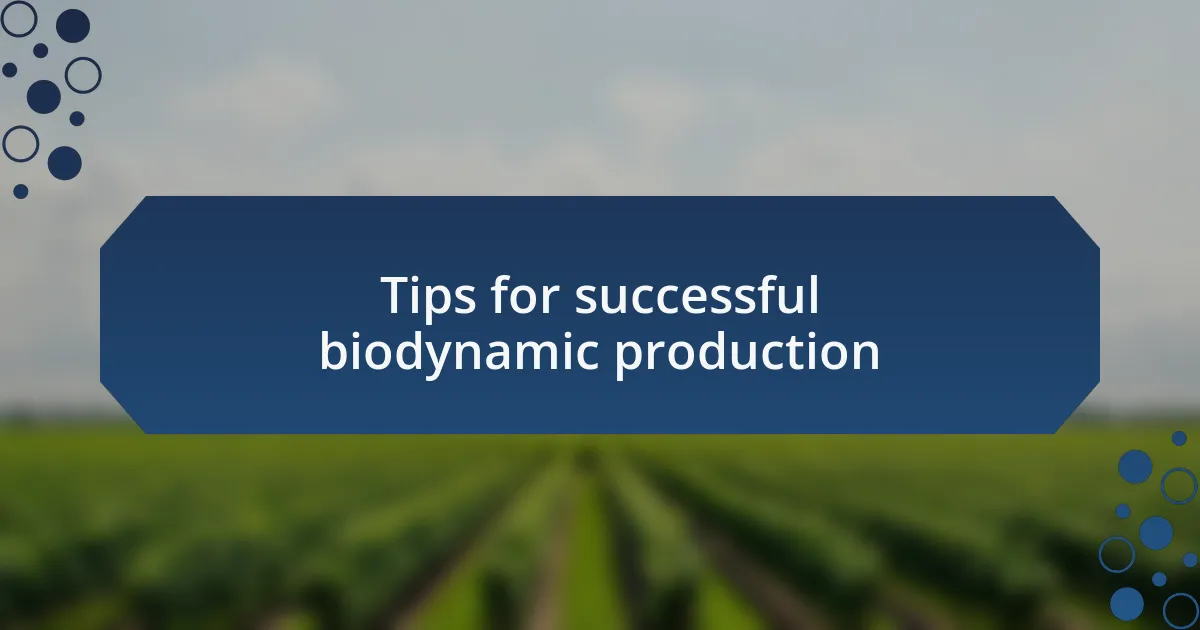
Tips for successful biodynamic production
One of the most important tips I’ve learned for successful biodynamic production is to embrace a deep connection with your land. I remember the first time I truly tuned into the rhythms of my vineyard; the changes in soil, the way the vines responded seasonally. It felt almost magical. Engaging with the land on this level not only enhanced my understanding of biodynamic principles, but it also made each decision feel more meaningful. How often do we take a moment to just listen to what our land is telling us?
Another key aspect is to keep communication open with fellow producers. I often find myself reaching out to others who share this journey. When I collaborated with a neighboring vineyard on a composting project, the shared knowledge was invaluable. We exchanged tips, and I discovered new approaches that I hadn’t considered before. It made me realize that we’re all in it together, and sharing our challenges can often lead to innovative solutions. Have you ever thought about how much you can learn just by connecting with others in your field?
Lastly, don’t underestimate the power of patience. I’ve had my share of setbacks—whether it was a failed experiment with a new planting technique or weather that didn’t cooperate. I’ve learned that biodynamic production is a marathon, not a sprint. With every challenge, I reminded myself that growth, both in the vineyard and within myself, takes time. So, when things don’t go as planned, take a deep breath and reflect on what you can learn from the experience. After all, isn’t the journey just as important as the destination?